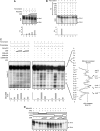Initiation of DNA repair mediated by a stalled RNA polymerase IIO
- PMID: 16407975
- PMCID: PMC1383516
- DOI: 10.1038/sj.emboj.7600933
Initiation of DNA repair mediated by a stalled RNA polymerase IIO
Abstract
The transcription-coupled repair (TCR) pathway preferentially repairs DNA damage located in the transcribed strand of an active gene. To gain insight into the coupling mechanism between transcription and repair, we have set up an in vitro system in which we isolate an elongating RNA pol IIO, which is stalled in front of a cisplatin adduct. This immobilized RNA pol IIO is used as 'bait' to sequentially recruit TFIIH, XPA, RPA, XPG and XPF repair factors in an ATP-dependent manner. This RNA pol IIO/repair complex allows the ATP-dependent removal of the lesion only in the presence of CSB, while the latter does not promote dual incision in an XPC-dependent nucleotide excision repair reaction. In parallel to the dual incision, the repair factors also allow the partial release of RNA pol IIO. In this 'minimal TCR system', the RNA pol IIO can effectively act as a loading point for all the repair factors required to eliminate a transcription-blocking lesion.
Figures





Similar articles
-
Mechanism of open complex and dual incision formation by human nucleotide excision repair factors.EMBO J. 1997 Nov 3;16(21):6559-73. doi: 10.1093/emboj/16.21.6559. EMBO J. 1997. PMID: 9351836 Free PMC article.
-
The Cockayne syndrome B protein, involved in transcription-coupled DNA repair, resides in an RNA polymerase II-containing complex.EMBO J. 1997 Oct 1;16(19):5955-65. doi: 10.1093/emboj/16.19.5955. EMBO J. 1997. PMID: 9312053 Free PMC article.
-
Recognition of RNA polymerase II and transcription bubbles by XPG, CSB, and TFIIH: insights for transcription-coupled repair and Cockayne Syndrome.Mol Cell. 2005 Oct 28;20(2):187-98. doi: 10.1016/j.molcel.2005.09.022. Mol Cell. 2005. PMID: 16246722
-
Transcription-coupled nucleotide excision repair in mammalian cells: molecular mechanisms and biological effects.Cell Res. 2008 Jan;18(1):73-84. doi: 10.1038/cr.2008.6. Cell Res. 2008. PMID: 18166977 Review.
-
The role of Cockayne syndrome group A (CSA) protein in transcription-coupled nucleotide excision repair.Mech Ageing Dev. 2013 May-Jun;134(5-6):196-201. doi: 10.1016/j.mad.2013.03.008. Epub 2013 Apr 6. Mech Ageing Dev. 2013. PMID: 23571135 Review.
Cited by
-
The pleiotropic roles of SPT5 in transcription.Transcription. 2022 Feb-Jun;13(1-3):53-69. doi: 10.1080/21541264.2022.2103366. Epub 2022 Jul 25. Transcription. 2022. PMID: 35876486 Free PMC article. Review.
-
Genetic instability associated with loop or stem-loop structures within transcription units can be independent of nucleotide excision repair.Nucleic Acids Res. 2018 Apr 20;46(7):3498-3516. doi: 10.1093/nar/gky110. Nucleic Acids Res. 2018. PMID: 29474673 Free PMC article.
-
Polynuclear ruthenium organometallic compounds induce DNA damage in human cells identified by the nucleotide excision repair factor XPC.Biosci Rep. 2019 Jul 15;39(7):BSR20190378. doi: 10.1042/BSR20190378. Print 2019 Jul 31. Biosci Rep. 2019. PMID: 31227614 Free PMC article.
-
Persistent TFIIH binding to non-excised DNA damage causes cell and developmental failure.Nat Commun. 2024 Apr 25;15(1):3490. doi: 10.1038/s41467-024-47935-9. Nat Commun. 2024. PMID: 38664429 Free PMC article.
-
The role of Bcl-x(L) protein in nucleotide excision repair-facilitated cell protection against cisplatin-induced apoptosis.DNA Cell Biol. 2009 Jun;28(6):285-94. doi: 10.1089/dna.2008.0815. DNA Cell Biol. 2009. PMID: 19317621 Free PMC article.
References
-
- Aboussekhra A, Biggerstaff M, Shivji MK, Vilpo JA, Moncollin V, Podust VN, Protic M, Hubscher U, Egly JM, Wood RD (1995) Mammalian DNA nucleotide excision repair reconstituted with purified protein components. Cell 80: 859–868 - PubMed
-
- Asahina H, Kuraoka I, Shirakawa M, Morita EH, Miura N, Miyamoto I, Ohtsuka E, Okada Y, Tanaka K (1994) The XPA protein is a zinc metalloprotein with an ability to recognize various kinds of DNA damage. Mutat Res 315: 229–237 - PubMed
-
- Bohr VA, Smith CA, Okumoto DS, Hanawalt PC (1985) DNA repair in an active gene: removal of pyrimidine dimers from the DHFR gene of CHO cells is much more efficient than in the genome overall. Cell 40: 359–369 - PubMed
Publication types
MeSH terms
Substances
LinkOut - more resources
Full Text Sources
Research Materials

